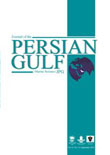فهرست مطالب

Journal of the Persian Gulf (Marine Science)
Volume:6 Issue: 21, Fall 2015
- تاریخ انتشار: 1395/09/30
- تعداد عناوین: 6
-
-
Pages 1-8The lipid content and composition of the reef-building coral Acropora downingi, the largest coral reef of Hengam Island, were examined throughout a year. The results showed that the lipid content of A. downingi significantly differs in different seasons (t-test, PKeywords: Acropora downingi, Hengam Island, Persian Gulf, Lipid, Fatty Acid
-
Pages 9-24Because of environmental sensitivity of the Caspian Sea, any subsea oil spills and blowouts can inflict destructive impacts on marine environment and cause catastrophic damage in the area. Employing mathematical simulation is one of the easiest and most effective prediction tools for understanding the oil spill behavior under various environmental forces. In this regard, Mike3D simulation package including 3D Flow and Ecolab-Oil Spill Modules were setup, verified and employed. Based on the environmental history of Caspian Sea area, it was decided to simulate the hydrodynamic behavior of the basin for the actual force driving parameters occurred in 1982. Then, according to various oil spill scenarios, it was attempted to simulate oil spill distribution in the basin for every season of the year. Results show how seasonal met-ocean parameters play as important key factors and can influence the oil spill transport and distribution in the area.Keywords: Mike3D, Ecolab-Oil Spill Module, Oil Blowouts
-
Pages 25-32In this survey, 54 specimens of common carp (Cyprinus carpio) were collected from Anzali Wetland between August 2011 and July 2012. After recording biometric characteristics, routine necropsy and parasitology methods were used. Totaly, 3165 individuals of parasites were isolated and identified from common carp. Parasitofauna consisted of 10 species as follows: two protozoans, Ichthyophthirius multifiliis and Trichodina sp.; two digenean trematodes, Diplostomum spathaceum and Posthodiplostomum sp.; two monogenean trematodes, Dactylogyrus extensus and Diplozoon nipponicum; two crustaceans, Lernaea cyprinacea and Argulus foliaceus; one cestode, Caryophyllaeus fimbriceps and one nematode, Raphidascaris acus larvae. D. extensus had the highest prevalence, mean intensity, dominance and abundance. The abundance of Trichodina sp. and C. fimbriceps in the age class of > 2 years old were significantly greater than that in the younger age classes. L. cyprinacea (copepodid stage) and C. fimbriceps showed the greatest abundances in summer and autumn, respectively. Trichodina sp. and L. cyprinacea (copepodid stage) showed significantly greater abundances in the eastern parts of the wetland compared with abundances of other stations.Keywords: Anzali Wetland, Cyprinus carpio, Parasite, Occurrence, Abundance
-
Pages 33-38The materials of this study were collected from intertidal and shallow subtidal habitats of the Hengam Island coasts from May 2013 to May 2014. A total of 10 species representing eight genera and four families are reported as follows: Sphaeromopsis persikolpos Khalaji-Pirbalouty and Wägele 2009, S. sarii Khalaji-Pirbalouty and Wägele 2009, Sphaeroma khalijfarsi Khalaji-Pirbalouty and Wägele 2010, Dynamenella granulata Javed and Ahmed 1988, and Cymodoce waegelei Khalaji-Pirbalouty & Raupach, 2014 (Sphaeromatidae); Baharilana kiabii Khalaji-Pirbalouty and Wägele 2010, Atarbolana exoconta Bruce and Javed 1987, and A. makranensis Khalaji-Pirbalouty, Naderloo and Keikhosravi 2015 (Cirolanidae); Ligia persica Khalaji-Pirbalouty and Wägele 2010 (Ligiidae); Olibrinus cf. antennatus Budde-Lund 1902 (Olibrinidae).Keywords: Isopoda, Sphaeromatidae, Ligiidae, Cirolanidae, Hengam Island, Persian Gulf
-
Pages 51-64In the present paper various transects perpendicular to Iranian Makran coasts (Chabahar-Gawater) were studied using satellite image processing, field observations, sandy shore profiling and grain size analysis to evaluate sedimentology and geomorphology of the area. Data revealed that the study area includes exposed rocky shores (52%), sandy shores (40%), and mud flats (8%) sheltered in estuaries. Forming spectacular landforms, coastal cliffs are the most frequent features in the area and have evolved by action of both coastal Makran uplift (1-6 mm.yr-1) and wave induced erosion. Due to high tectonic activity and severe longshore drifting, sandy shores are narrow and less developed. The location and direction of backshore sand dunes observed by satellite images suggests that they are developed on top of cliffs and along paleoshorelines as a result of strong southwest monsoon winds. Estuaries formed by sedimentation of seasonal creeks are mostly sheltered by longshore associated sand barriers and spits. In some of estuaries, such as Bahukalat and Tiss, salt marshes are observed in mangrove forests. In general, the overall shape of Makran coastlines is governed by structural pattern of coasts. Other processes shaping coastal features include wind action, water runoff and weathering by physical, chemical or biological agents. Wave action, especially during summer monsoon has a fundamental role in coastal change.Keywords: Makran, Sedimentology, Coastal Landforms, Wave Action
-
Pages 65-77There is a need to increase our knowledge about phytoplankton diversity and distribution in the Iranian waters of the Persian Gulf and the Gulf of Oman. Phytoplankton samples along with environmental parameters of the Northeastern waters of the Gulf of Oman (Gordim Bay towards Gwadar Bay) were collected and recorded prior to summer monsoon (Mid of March 2013). Seven inshore and six offshore stations in two depth profile (0.5 m, 10 m) were sampled. A total of 26 genera were identified which comprised of 21 taxa from inshore and 17 taxa form offshore stations. Bacillariophyceae constituted the most dominant taxa, among which Rhizosolenia spp., Chaetoceros spp. and Pseudo-nitzschia spp. were more abundant diatoms. The dominant dinoflagellates were Ceratium furca and C. breve. The maximum and the minimum count of phytoplankton per station were 3975 and 53 cells/L. The difference in the species composition of inshore and offshore phytoplankton was significant, and the highest number of phytoplankton was recorded from the eastern coast of the study area. However, there was no significant difference between population numbers of surface water (0.5) and at 10m depth. Among the measured hydrological factors, silicate, chlorophyll a, and dissolved oxygen showed potential effect in spatial distribution of phytoplankton. Some toxic genera were observed but their occurrence was not at harmful bloom rate.Keywords: Phytoplankton, Distribution, Middle ROPME Sea Area, Inshore, Offshore

